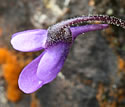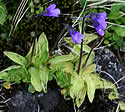Pinguicula vulgaris (Butterwort)
| Also known as: | |
|---|---|
| Genus: | Pinguicula |
| Family: | Lentibulariaceae (Bladderwort) |
| Life cycle: | perennial |
| Origin: | native |
| Status: |
|
| Habitat: | part shade, sun; cold, wet cliffs and ledges, mossy bolders, rocky shores |
| Bloom season: | June - July |
| Plant height: | 1 to 6 inches |
| Wetland Indicator Status: | GP: none MW: none NCNE: OBL |
| MN county distribution (click map to enlarge): |  |
| National distribution (click map to enlarge): |  |
Pick an image for a larger view. See the glossary for icon descriptions.
Detailed Information
Flower: 

![[photo of flowers]](/udata/r9ndp23q/pd/pinguicula-vulgaris-12-31-t.jpg) A single tubular flower at the end of slender, curved stalk. Petals are deep violet, the shape almost like a violet with 2 upper, rounded oval lobes and 3 lower, the fused tube base tapering to a long spur at the back. Flowers are ½ to ¾ inch long including the spur. The open throat is lighter violet to white with stiff, glandular hairs on the lower lobes. Five deep purple to reddish brown, lance-like sepals, covered with fine hairs, clasp the top of the flower where it attaches to the stalk.
A single tubular flower at the end of slender, curved stalk. Petals are deep violet, the shape almost like a violet with 2 upper, rounded oval lobes and 3 lower, the fused tube base tapering to a long spur at the back. Flowers are ½ to ¾ inch long including the spur. The open throat is lighter violet to white with stiff, glandular hairs on the lower lobes. Five deep purple to reddish brown, lance-like sepals, covered with fine hairs, clasp the top of the flower where it attaches to the stalk.
Leaves and stems: 

![[photo of leaves]](/udata/r9ndp23q/pd/pinguicula-vulgaris1-t.jpg) 3 to 6 light green to yellowish green leaves form a basal rosette, the blades oval to elliptic, ¾ to 2 inches long, the edges curled inward and the surface covered with sticky hairs that trap insects. Each plant can have 1 to 3 dark reddish purple flowering stems, 2 to 6 inches long, covered with sparse, fine hairs.
3 to 6 light green to yellowish green leaves form a basal rosette, the blades oval to elliptic, ¾ to 2 inches long, the edges curled inward and the surface covered with sticky hairs that trap insects. Each plant can have 1 to 3 dark reddish purple flowering stems, 2 to 6 inches long, covered with sparse, fine hairs.
Fruit: 
![[photo of fruit]](/udata/r9ndp23q/pd/pinguicula-vulgaris-001-t.jpg) Fruit is an ovoid capsule ¼ to 1/3 inch long with the stub of the style persisting at the tip. The flowering stem becomes erect as the seeds inside mature.
Fruit is an ovoid capsule ¼ to 1/3 inch long with the stub of the style persisting at the tip. The flowering stem becomes erect as the seeds inside mature.
Notes:
Butterwort is one of Minnesota's 15 carnivorous plants that capture insects for nourishment. While many butterwort species inhabit moist tropical habitats, P. vulgaris is a circumboreal species restricted to cold, rocky cliffs and boulders found at higher elevations, and along the northern stretches of Lake Superior's shoreline that get adequate moisture but are sheltered against excessive sunlight. It is also common in bogs and wet meadows into the high arctic. According to the DNR, it was listed as a Special Concern species in 1984 due to its limited available habitat, at risk from development and trampling from recreational activities along the North Shore. It is listed as Endangered in Wisconsin.
Native Plant Nurseries, Restoration and Landscaping Services ↓
More photos
Photos courtesy Peter M. Dziuk taken along the north shore of Lake Superior in Cook and Lake counties.
Comments
Have you seen this plant in Minnesota, or have any other comments about it?
on: 2013-06-19 18:44:36
I photographed and identified a small group of this species growing in a rocky area on the Lake Superior coast, near the Grand Marais breakwater.
on: 2017-06-07 19:40:40
"Peak"now, beautiful!
on: 2017-10-03 11:10:23
I have seen them growing in cracks along with other alpine or rocky habitation plants like harebells, etc. they likes cracks without any tree or shrubs cover that are high enough above Lake Superior so they may get spray by high waves or fog moistures. That's why you won't find them in rocky drier sites they need cool temperatures and constant light moistures to survives.
on: 2018-06-24 23:08:28
Found a nice sized colony on ledge rock along the Lake Superior shore, along with Bird's Eye Primrose and Elegant Groundsel.
on: 2018-07-04 23:05:56
I am looking for a trail to find them on. Does anyone have a specific location?
on: 2018-07-05 06:56:36
Jill, butterwort doesn't grow along trails. You would need to climb among the rocks on Lake Superior's north shore to see them. I would also not publish exact coordinates for anyone to see. The rocky habitat is surprisingly fragile and is destroyed by too much foot traffic. Case in point: Artist Point in Grand Marais used to be home to dozens of plant species, some of them quite rare, but its popularity as a tourist spot has trashed the place so there is very little left. :-(
on: 2018-07-19 09:44:39
There is a very small colony on Lighthouse Point in Two Harbors. They are somewhat sheltered by a depression, reducing the chances of being stepped on. I recognized them by their pail yellow-green leaves since they were not flowering two weeks ago.
on: 2019-10-16 10:05:41
Jill S-St Louis Park I'm pretty sure I saw these leaves when backpacking between Caribou Lake to Cascade State Pk. Although, "not found on trails", it is was a rocky, muddy trail with many streams. I think it's possible what I saw. It is the end of the season, so could not view the full plant. I kept thinking the leaves looked a lot like bluebead lilies only slightly different. BTW was really impressed with the observation of "leave no trace" on the Superior Hiking Trail.
on: 2021-06-05 18:53:42
Several growing and blooming among rocky habitat along shore, along with Mistassini Primrose.
on: 2021-07-11 15:58:07
Seen growing near Father Baraga's Cross Historical Marker. After bloom, but fruits could be seen. Really a special looking leaf.
on: 2023-03-02 14:48:23
You'll find them on the North Shore, where the land protrudes into Lake Superior. The subtle climate change vs. the mainland is just enough!
on: 2023-06-12 12:19:48
A nice population among the shore rocks. Most were rimming the "tidal pools" amongst some sedges. Most all were blooming or were starting to.
on: 2023-07-24 20:05:21
Easy to find this fun plant on Artist's Point in Grand Marais. Look along the "tide pools" on the north side of the rocks. I have found it on both the lighthouse side and the side with more of a forest. Artists point in general is a good place to find this easily and it gets so much foot trafic anyways you don't have to feel too bad about messing things up, though of course you should leave no trace and tread carefully.
on: 2024-03-10 16:10:48
I saw multiple sizable colonies at Temperance state park along the rocky shore heading north







 Butterwort plant
Butterwort plant Butterwort habitat
Butterwort habitat